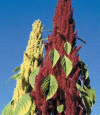Development of a nutrient-dense complementary food using amaranth-sorghum grains
- PMID: 28070319
- PMCID: PMC5217873
- DOI: 10.1002/fsn3.367
Development of a nutrient-dense complementary food using amaranth-sorghum grains
Abstract
Thin porridge from cereals and starchy tubers is a common complementary food in Sub Saharan Africa. It may be high in antinutrients, low in energy, and nutrient density hence inadequate in providing infants' high energy and nutrients requirements per unit body weight. Consequently, undernourishment levels among children under 5 years are high. Therefore, there is need to avail nutrient-dense complementary foods especially for children in low-resource settings. The study was aimed at developing a nutrient-dense complementary food from amaranth and sorghum grains. Amaranth grain, a pseudocereal, though rarely used as a complementary food in Kenya has a higher nutritional quality than other staples. Plant-based foods are known to have high levels of antinutrients. Steeping and germination were used to reduce the levels of antinutrients and enhance the bioavailability of minerals in the grains. Various steeped and germinated amaranth and sorghum grains formulations were made to find the ratio with the highest nutrient content and lowest antinutrient levels. The 90% amaranth-sorghum grains formulation had significantly (F = 32.133, P < 0.05) higher energy (5 kcal per g on dry weight basis) than the other formulations and a protein content of 14.4%. This is higher than the estimated protein needs from complementary foods even for a 12-23 months child of low breast milk intake (9.1 g/d). Antinutrients could not be detected which could imply enhanced nutrient bioavailability. Therefore, a nutrient-dense complementary food product was developed from steeped and germinated amaranth and sorghum grains with 90% amaranth grain. In ready to eat form, it would give an energy content of 1.7 kcal per g (dilution of 1:2 amaranth-sorghum flour to water) and 1.2 kcal per g (dilution of 1:4 amaranth-sorghum flour to water). It can be used as a nutrient-dense complementary food and for other vulnerable groups.
Keywords: Antinutrients; grain amaranth; nutrients; processing; stunting.
Figures
Similar articles
-
Nutritional evaluation of complementary porridge formulated from orange-fleshed sweet potato, amaranth grain, pumpkin seed, and soybean flours.Food Sci Nutr. 2021 Dec 16;10(2):536-553. doi: 10.1002/fsn3.2675. eCollection 2022 Feb. Food Sci Nutr. 2021. PMID: 35154690 Free PMC article.
-
Complementary foods for infant feeding in developing countries: their nutrient adequacy and improvement.Eur J Clin Nutr. 1998 Oct;52(10):764-70. doi: 10.1038/sj.ejcn.1600645. Eur J Clin Nutr. 1998. PMID: 9805226
-
Optimized formulation and processing protocol for a supplementary bean-based composite flour.Food Sci Nutr. 2015 May 15;3(6):527-38. doi: 10.1002/fsn3.244. eCollection 2015 Nov. Food Sci Nutr. 2015. PMID: 26788294 Free PMC article.
-
Complementary feeding: a global perspective.Nutrition. 1998 Oct;14(10):763-6. doi: 10.1016/s0899-9007(98)00079-3. Nutrition. 1998. PMID: 9785357 Review.
-
Current and potential role of specially formulated foods and food supplements for preventing malnutrition among 6- to 23-month-old children and for treating moderate malnutrition among 6- to 59-month-old children.Food Nutr Bull. 2009 Sep;30(3 Suppl):S434-63. doi: 10.1177/15648265090303S305. Food Nutr Bull. 2009. PMID: 19998866 Review.
Cited by
-
Effect of Amaranth-Containing Dietary Intervention in Improving Hemoglobin Concentration: A Systematic Review and Meta-Analysis.Public Health Rev. 2025 Jan 3;45:1607597. doi: 10.3389/phrs.2024.1607597. eCollection 2024. Public Health Rev. 2025. PMID: 39829607 Free PMC article.
-
Moisture sorption isotherm and shelf life prediction of complementary food based on amaranth-sorghum grains.J Food Sci Technol. 2020 Mar;57(3):962-970. doi: 10.1007/s13197-019-04129-2. Epub 2019 Oct 19. J Food Sci Technol. 2020. PMID: 32123417 Free PMC article.
-
Evaluation of adaptability and stability for iron, zinc and protein content in cowpea genotypes using GGE biplot approach.Heliyon. 2022 Nov 30;8(12):e11832. doi: 10.1016/j.heliyon.2022.e11832. eCollection 2022 Dec. Heliyon. 2022. PMID: 36506391 Free PMC article.
-
Multi-response optimization of extrusion conditions of grain amaranth flour by response surface methodology.Food Sci Nutr. 2019 Nov 20;7(12):4147-4162. doi: 10.1002/fsn3.1284. eCollection 2019 Dec. Food Sci Nutr. 2019. PMID: 31890194 Free PMC article.
-
Effect of Fermentation on Nutritional Quality, Growth and Hematological Parameters of Rats Fed Sorghum-Soybean-Orange flesh Sweet Potato Complementary Diet.Food Sci Nutr. 2020 Dec 8;9(2):639-650. doi: 10.1002/fsn3.2013. eCollection 2021 Feb. Food Sci Nutr. 2020. PMID: 33598149 Free PMC article.
References
-
- Aggett, P. J. , Agostoni C., Axelsson I., Edwards C. A., Goulet O., Hernell O., et al. 2003. Non digestible carbohydrates in the diets of infants and young children. J. Pediatr. Gastroenterol. Nutr. 36:329–337. - PubMed
-
- Alemu, J. 2008. The African executive development. Artsvisval. Available at: www.africanexecutive.com/modules/ma (accessed 28 April 2008).
-
- Antony, U. , and Chandra T. S.. 1998. Antinutrient reduction and enhancement in protein, starch and mineral availability in fermented flour of finger millet (Eleusine corocan). J. Agric. Food Chem. 46:2578–2582.
-
- AOAC . 1995. Official methods of analysis. 16th ed Association of Official Analytical Chemists, Washington, DC.
-
- Burgess, A. , and Glasauer P.. 2004. Family nutrition guide. Food and Agriculture Organization of the United Nations, Rome.
LinkOut - more resources
Full Text Sources
Other Literature Sources





